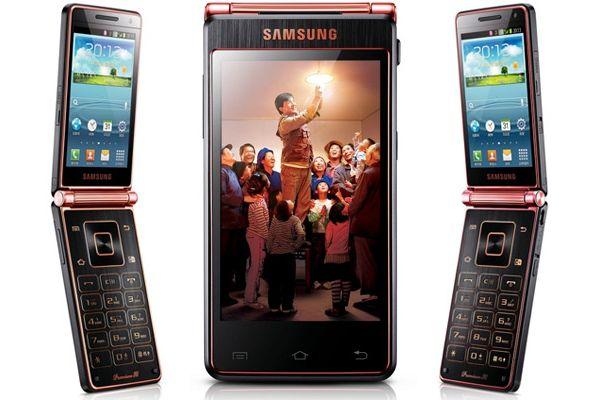
It has probably been a long time since you've last used a flip phone - on purpose, anyway. We've all had those times where we've probably had to break out the old flip-a-roo for one reason or another: screen cracked on our smartphone, bricked phone, liquid damage... most of us have been there and done that. It's likely been a long time since many of us have seriously considered purchasing a flip phone to be our next main squeeze for the next two years of our lives, but what if there was a way to bring it back? What if you could combine an Android device with a flip phone?
It looks like Samsung is giving this idea another attempt with the reported Samsung Galaxy Golden (previously called the Galaxy Folder), a 3.7-inch dual-screen LTE flip device running Android 4.2, and will release in South Korea. Samsung has used this hybrid design before in December of 2011 with the SCH-W999; other companies used the same design prior to Samsung.
Each attempt has only ever been available to eastern countries, but sometimes I wonder whether an idea like this could work in the United States or not. Especially if it's a lower-end device made by Samsung, it almost seems like there's nothing to lose. They're already releasing a thousand and one phones anyway, what's one more?
The very first hybrid Android/clamshell device came from a company called Sharp. You may recall hearing about the device: the Sharp AQUOS PHONE THE HYBRID SoftBank 007SH. I'm not sure why the model is in all caps; maybe because if you say it louder it instantly becomes more important. Important it was, because despite the retro cell phone design the phone actually touted some extremely impressive specs for 2011 - specs that we are just now pulling up on today. Not only did this clamshell feature a 16-megapixel camera, but it also claimed to be dust-proof and water-proof (see: resistant). Aside from those two features, the phone was pretty much what would expect to see in 2011. It still had three huge things going for it, which was the much improved camera, the protective features, and of course the foreign yet not-so-foreign design that was actually quite workable in more than one way. This device was more than just a flip phone, because you didn't have to use it as just a flip phone.
It looks like any other clamshell when it's closed. There's a small outer display for the time and notifications, and the rear featured a pretty impressive looking shooter (as it should, being 16-megapixels and all). You open the phone to a 3.4-inch display and a traditional numeric pad, with some extras thrown in for functionality. That's all fine and dandy, but in the case that you would rather use it as a full touchscreen device, you could. You simply pivot the screen and lay what would normally be the external screen against the numeric keypad, allowing you to transform the phone into a full-touchscreen device and still allowing access to that fantastic camera on the back. You have Android, multi-purpose functionality, and nostalgia all rolled into one. How could anybody hate that?
Unfortunately, the device never made it out west simply because there wasn't enough interest expressed in the device. There had been reports that the phone was on its way, but it never happened. In fact, no hybrid flip phone ever made it out this way. Is this new model, the Samsung Golden, going to end up in the U.S.? Probably not, but if it did, I would be extremely interested in a device like this. It seems to me like smartphones here just have one stationary design lately: candybar. We used to have slide-out QWERTY keyboards, and now we really don't. We used to have oddly designed phones, like the Motorola CHARM, the Samsung Replenish, or even the Sidekick 4G. Now all you see advertised is candybar, candybar, candybar with a stylus, and more candybar. Candybar works, but sometimes it's nice to just have something weird and different, even if it is borrowing from designs of cell phone's past.
I will admit that I'm more fond of Sharp's design for a flip phone Android, simply because the pivoted screen made more sense. You could use it as an almost-traditional flip phone, or you could use it as an almost-traditional Android. Samsung decided to use dual-screens, so trying to pass it off as a traditional flip phone is pretty much a no-go. It's still an interesting concept by bringing back the numeric keypad, and regardless of the dual screen it is still something that, I think, would be worth trying out.
Readers, what are your thoughts on a hybrid flip phone/Android device? Would it be something that you could see yourself wanting to use, or is it just too bizarre of a concept to jump on board with? Let me know your thoughts in the comments!
Images via Content Explore, Mobile Mag